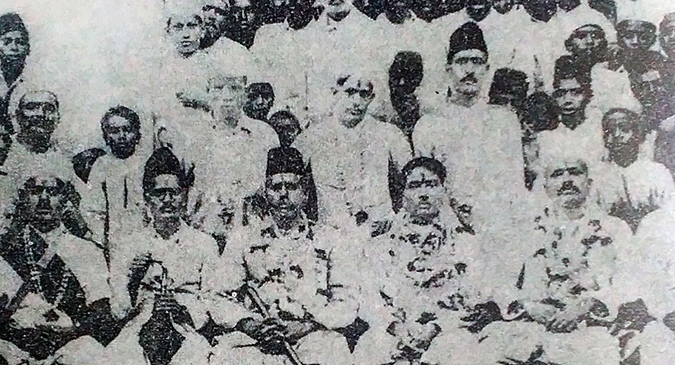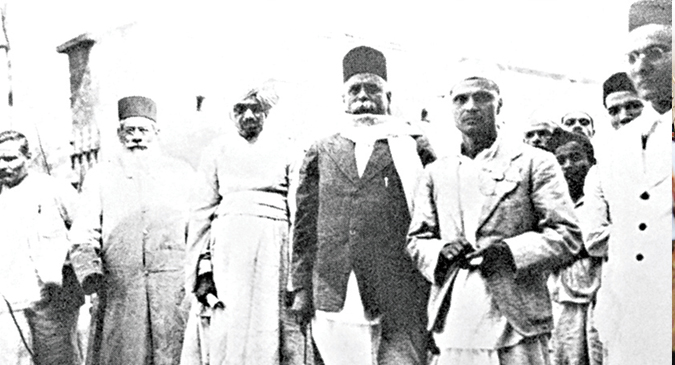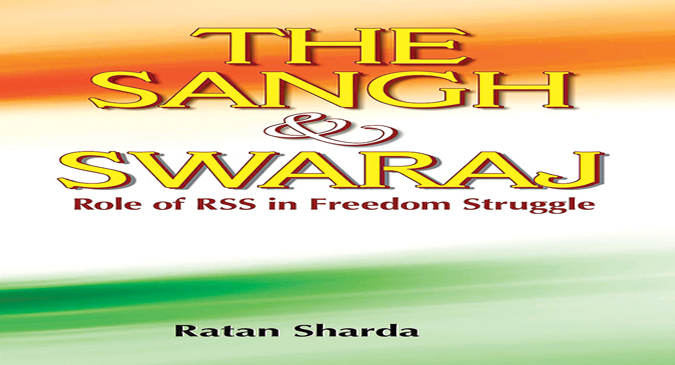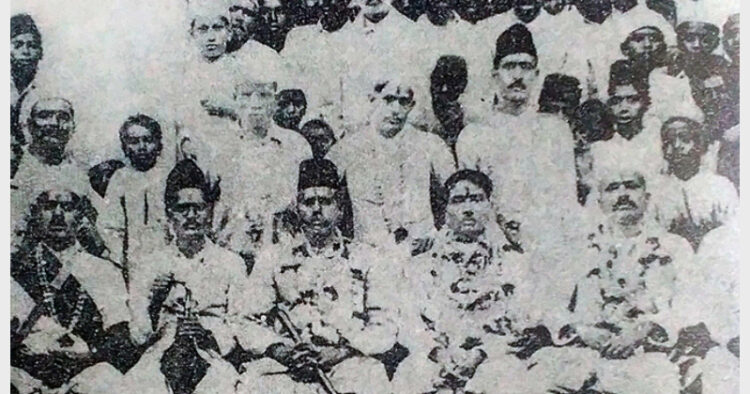Shri Ratan Sharda in his book ‘The Sangh & Swaraj- Role of RSS in Freedom Struggle’ debunks the malicious propaganda of left-liberals to slander the RSS
Astha Singh
Despite RSS being a united monolithic organisation, which functioned as a major force during a time when the nation was under siege, the recent political developments in the country have deliberately bypassed the well-documented role of the Sangh in the freedom struggle. Thereby, ensuring the twisted agenda of the left as well as other self-proclaimed secular parties to maximise and further build on the narrative that ‘the Congress Party was the only party that ensured freedom for Bharat inconsequential to the role of its leaders and their respective independent organisations which they headed or were a part of’. This is where Shri Ratan Sharda’s book, The Sangh & Swaraj: Role of RSS in Freedom Struggle, provides the reader with perfect insight into the Bharat that was struggling for Independence. The book provides a series of facts, records, personal accounts, handwritten notes and stories that are well cited from across Bharat meticulously elaborating on the Role of Sangh and its swayamsevaks in the freedom movement.

Dr Hedgewar during the 1930 Satyagraha against the British
The book begins with a simple description of the early life of Dr Hedgewar from his dismissal from school for resisting the ‘Risley Circular’ that banned the slogan ‘Vande Matram’ in 1906 to giving up the comforts of married life for the national interest. It was Dr Hedgewar who first presented the concept of ‘Complete Freedom’ as Joint Secretary of the State Congress Committee in 1920 while outrightly calling the British Rule as ‘Capitalist Imperialism’ before the Congress resolution committee which merely sought for ‘Self Rule’ as a dominion under British Rule. With his involvement in all thre major movements of Non-Violence under the leadership of Gandhiji (i.e. during 1921 and 1930) he was imprisoned for one year for his active participation and the role in Non-Cooperation Movement in August 1921. There were also numerous bans on his speeches across the country by British administration for his role in strengthening the Non-Cooperation Movement.

Dr Hedgewar being welcomed at Hindu Yuvak Parisahd, Pune along with (L-R) Dr Munje, Benodikar, Nalavade and VD Savarkar
The book also contains references to how the Congress administration opposed the role of other relevant organisations like that of Dr NS Hardikar who formed the Hindustani Seva Dal in 1923 to create a sense of discipline among Congress volunteers and not just raise directionless and anarchic volunteers. Eventually, with the idea of raising the nation above caste and creed, envisioning the nation which is free from the evils of oppressive customs and putting efforts to gather the national consciousness without propaganda, the Rashtriya Swayamsewak Sangh was founded in 1925 on Vijayadashmi Day with 22 members. After almost a decade of presenting the idea of “Complete Freedom” in 1920, the RSS under Dr. Hedgewar welcomed the Congress declaration of “Complete Freedom” during Lahore session in December, 1929 by sending out a notification to all the RSS Shakhas asking everyone to join for a ceremony on the eve of 26th January, 1930 for saluting the Bhagwa Flag (As per the recommendations of AICC a rectangular Bhagwa Flag with a Charkha in the left corner was a recognised flag).
Sangh and the Satyagraha
The role of the Sangh in Dandi March in 1930 was evident with the participation of Dr Hedgewar along with his resignation from the RSS as Sarsanghachalak as he was of the view that freedom struggle must be fought under one organisation that was Congress. He also strongly reiterated that while one can join the Congress agitation, one can also remain in the RSS and work for constructive freedom of the nation while simultaneously working towards reforming a Hindu society.

After conducting Satyagraha in Yavatmal on 21st July 1930, he was given 9-month imprisonment with hard labour, more than 100 swayamsevaks were sent to Akola Jail with Dr Hedgewar. In spite of reluctance from Hindu Mahasabha regarding RSS joining the Non-Cooperation movement, Dr Hedgewar continued to extend his support while simultaneously maintaining cordial relations in the larger interest of the nation.
- While RSS became a brand post-independence for its extraordinary efforts in relief and rehabilitation work, the Congress seemed to take a political dislike for it by suppressing its cadre under the garb of Gandhiji’s assassination
- After the demise of Dr Hedgewar in June 1940, the RSS continued to contribute to the freedom struggle under the leadership of the then Sarsanghachalak Shri M.S. Golwalkar or Shri Guruji
With the rise in the popularity of the RSS and its involvement in the freedom struggle, the British administration under Section 23 of Government Rules clearly barred any government servant from becoming a member or even participating in the activities of the RSS in 1932. In fact, it was the British Secretary, M.G. Hanlet that issued an order in January 1933 to collect detailed information on RSS knowing the RSS was majorly expanding even with the banning. Finally, the British had to take some necessary step to stop the expansion of RSS and hence another order from December 1933 issued by the British Secretary tagged the RSS as “communal” and banned the teachers from joining the organisation as well. In 1934 session of Madhya Prant assembly many Congress representatives firmly stood against this ban and were in favour of the RSS. The book is thus full of some small and big acts of various swayamsevaks that contributed in their own way to the freedom struggle.
RSS in Quit India Movement
After the demise of Dr Hedgewar in June 1940, RSS continued to contribute to the freedom struggle under the leadership of Shri M.S. Golwalkar, popularly known as Shri Guruji. As the Quit India Movement was announced in 1942, the fiercest agitations took pace in Vidarbha region where RSS network was strongest. The agitation was led by RSS leaders Dada Naik, Baburao Begade and Annaji along with Congress leader Uddhavrao Korekar where a young swayamsevak named Balaji Raipurkar was killed. This was followed by the famous Chimur encounter called as “Chimur Ashti episode” where 125 Satyagrahis and thousands of swayamsevaks were imprisoned, swayamsevak Hemu Kalani and RSS leader Dada Naik were sentenced to death in 1943. The author has also provided a list of swayamsevaks who were sent to prisons for their active participation in the Quit India Movement throughout the country. In 1942, six agitators trying to hoist the national flag on a government secretariat were killed in police firing, two of them were young swayamsevaks named Devipad Chaudhary and Jagatpati Kumar. Apart from endless acts of bravery of the swayamsevaks directly involved in the freedom struggle the RSS played a crucial role in providing shelters to senior Congress leaders such as Aruna Asaf Ali, Socialist leaders like Achyutrao Patwardhan as well as revolutionaries like Nana Patil and Rajguru who after successful killing of Saunders had gone underground by the efforts and arrangements made by Dr Hedgewar.
The Quit India Movement was a monumental moment in the history of India and the history of the Sangh with numerous efforts made by the RSS and unconditional support extended to Congress leaders in every way possible to achieve a single goal of Swaraj. The British closely monitored the functioning of the RSS from time to time and regular reports were exchanged between the CID, Home Department and British intelligence regarding the day to day activities of the Sangh describing them as “Anti British volunteers who were ready to sacrifice their lives for the cause of the country”. One of the reports of British Intelligence in 1943 clearly stated that. “The ulterior objective of the RSS is to drive the British away from India and free the country”.
After the Independence
The most interesting part of the book is indeed the inexplicable contribution of the RSS during the massive tragedy and the price with which came the Independence of this great nation due to the mishandling of the Partition, eventually leading to thousands of victims due to utter chaos. It is this period that saw the extensive contribution of RSS leaders like Guruji, Babasaheb Apte and Balasaheb Deoras. The support that Congress enjoyed from RSS while being threatened by the Muslim League members during 1946 is the reason for various political events of the Congress to conclude peacefully and graciously. As per the admittance of another Congress leader named Radhakrishnan Seth in conversation with Nehru is that “RSS is not a group of mindless youth but an organisation of ready to save the nation patriotic youth”. The announcement of the Partition witnessed the setting up of Punjab Relief Committee and Hindu Sahayata Samiti for providing support and relief to the victims of Partition under the leadership of Guruji.
One such letter of Sadar Harvansh Singh describing the role of the RSS swayamsevaks standing as human barriers protecting the Sikh brothers from the atrocities of the Muslim League which resorted to rioting and attacking Hari Mandir Saheb certainly brings shiver down the spine. It is important to highlight the role of Rashtra Sevika Samiti and its Sanchalika Smt. Laxmibai Kelkar, Sheela Kriplani and Jethi Dewani whose valuable contribution is also brought to light in this book. What specifically captured my interest is the mention of my maternal village Kotli, the stories of which are often told to us by our elders and how the swayamsevaks joined hands with the Army and the Hindus of Kotli village to defend the Muslim soldiers who joined enemy camps. Kotli witnessed the death of six swayamsevaks who died while crawling into the enemy territory to pick up 12 boxes of ammunition and medicine airdropped for the army. The swayamsevaks helped the Army tremendously in areas like Poonch, Kotli, Rajouri, Udhampur, Dev Batala, Skardu, Mirpur, etc assisting them in landing 35 aircrafts every day and evacuating 40,000 people every day safely.
Under Guruji’s leadership, proper mechanism for rehabilitation of the fighters of freedom movement was prepared and swayamsevaks were systematically placed to provide assistance. It is interesting to note the role of Samitis established by Sangh such as Purusharthi Sahayta Samiti and Bastuhara Sahayta Samiti which opened relief camps, collected funds worth Rs 8 lakh, 1500 bales of cloth and grains that helped thousands of victims of hunger. It is evident from the author’s research that the role of RSS in the freedom struggle was not just limited to the struggle of achieving independence but also to ensure the safe passage of women and children, facilitating medical supplies, clothing, providing patrol assistance in the terrible conditions of the camps. High-rank leaders like Sardar Patel have appreciated the role of RSS in the aftermath of Independence and how their fearless abilities helped save the lives of many Hindus and Sikhs. While the Sangh was requested for the safety of Gandhiji while staying in a Harijan village surrounded by a Muslim community, Gandhiji addressed the RSS swayamsevaks on 16th March 1947 and concluded that “Sangh is a highly well organised and disciplined organisation. Its strength can be used for the good of Bharat or against it. I don’t know if the accusations against the Sangh are true or not, it is up to Sangh to prove them wrong”.
The closing chapter of the book brilliantly makes way for the author to touch upon the premise of the political banning of the RSS as a Congress-Left vendetta. And why Gandhiji’s persistent advocacy of the dissolution of the Congress to let multiple parties rise out of different ideologies was constantly unheard and brushed aside. While RSS became a brand post-Independence for their extraordinary efforts in the relief and rehabilitation work, the Congress seemed to take a political dislike for the RSS by suppressing them under the garb of Gandhiji’s assassination which by Guruji’s admittance was an “Unpardonable and Anti National Act”.
I would highly recommend this book to young adults who truly wish to understand the Sangh and know about its contribution to the building of a nation. It is an eye-opening insight into many accounts throughout history that typically capture your imagination and leave you for wanting more.













Comments